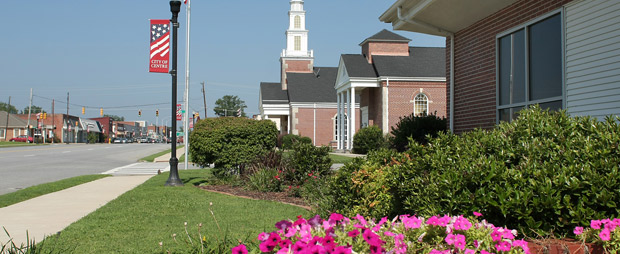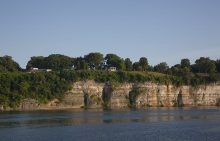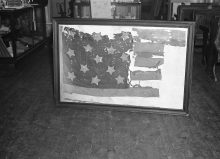In 1844, there was a disagreement about the center of Cherokee County [see film]
HUGH CARDON’S HISTORY OF CHEROKEE COUNTY ALABAMA1
Part VII
In 1844, a great deal of dissatisfaction arose in the County over the Courthouse, resulting in the Legislature appointing a committee of citizens to ascertain the exact center of the County. This committee consisted of Jas. Montgomery, Magnus G. Williams, A. G. Copeland, Thomas Garrett, Jos. Wharton, Aaron Clifton, and A.R. Brindley. This commission made a thorough investigation and selected the hill on which the town of Centre now stands.
Downtown Centre, Alabama 2014
One dwelling on Centre hill
At that time, however, there was only one dwelling on Centre hill and that a log one, which stood where the ‘club house’ or residence of E. M. Sheppard, now stands. An election was then held on the first Monday in April 1844 the people being given an opportunity to vote on whether the Courthouse should remain at Cedar Bluff or be moved to the central location selected by the Commissioners, and the central location won.
On January 27, 1846, the Legislature appointed another committee to lay off the town of Centre, to sell lots, and to erect public buildings. This committee consisted of Messrs. Wharton, Clifton, Garrett, Brindley, and Asa W. Allen. Mr. Allen was a surveyor and, with the assistance of Moses Hampton, a Negro Methodist preacher, laid off the town and drew the first town plat. Within a few years the United States Land Office was moved from Lebanon to Centre and the town started to grow slowly. The first newspaper established in Centre was the Argus, in 1854 by L. Stiff, which continued until shortly after the Civil War.
Fifteen companies to the Confederate Army
Cherokee County furnished fifteen companies of infantry and two of cavalry to the Confederate Army. The 19th Alabama Regiment of Infantry was composed almost entirely of Cherokeeans. The first colonel of the 19th Alabama was Joseph Wheeler, who all know, later became one of the outstanding cavalry leaders of the Confederacy. After Wheeler’s promotion to a generalship, he was succeeded by S. K. McSpadden of Centre. The 19th Alabama participated in some of the most sanguinary conflicts of the war, including Corinth, Shiloh, Chickamauga, Missionary Ridge, Franklin, and Atlanta. Towards the end of the war, the infantry was under the command of Gen. E. W. Pettus, and surrendered at Salisbury, North Carolina.
One of the most daring feats in all military history occurred in this County. In April 1863, Col. Abel D. Streight, with a command of over two thousand Federal troops, was ordered from Tuscumbia to proceed south and east to destroy Confederate foundries and munitions factories, especially in Cherokee County and in Rome, Georgia. Gen. Bragg, having become acquainted with this information, dispatched Gen. Forrest, the wizard of the South in pursuit of the Yankee troops.
At a point near Blountsville Forrest overtook Streight, and a running battle ensued from that place to Black Creek, near Gadsden. The Yankees reached Black Creek first rapidly crossing over and then fired the only bridge in the neighborhood, completely cutting off Forrest’s pursuit. For a few minutes it seemed that a victory which had been so imminent had vanished, when, of a sudden, a young woman, wearing a linzey dress and sun bonnet, ran up and offered to pilot Forrest and his troops to a ford.
Emma Sansom received a rousing cheer
This gallant general helped the young lady into the saddle behind him and rode towards the ford. Yankee soldiers across the creek started firing, but when Emma removed her bonnet and the troops saw that there was indeed a girl in Forrest’s saddle, they not only ceased firing, but gave her a rousing cheer. (Editor’s note: This was Emma Sansom.)
The Confederates stayed on the Federals’ heels until they reached the Lawrence farm just above Cedar Bluff at dawn on May 3, 1863, and stopped for a moment’s rest. They had no sooner dismounted than Forrest’s troops were seen at a distance and in a few minutes a courier reached Gen. Streight under a flag of truce, bearing a note requesting immediate surrender.
A conference was then held between the two leaders; during this meeting a-courier rode up to Gen. Forrest and stated that Gen. Van Dorn with a division of troops was stationed a half-mile distant, awaiting orders. Just as this courier was leaving, another rode up with the statement that Gen. Roddey presented his compliments and was awaiting orders. Forrest replied to both that they were to instruct their commanders to await his signal gun, whereupon a charge was to be made. Of course, there was no Gen. Roddey or Van Dorn in the State, but the strategy so dismayed Streight that he readily agreed to the terms demanded by Forrest and surrendered his entire troops.
1Mr. Hugh Cardon wrote the following history of Cherokee County on the occasion of the 100th anniversary of the county in 1936. This history was published in the COOSA RIVER NEWS on Friday, August 7, 1936. Mr. Cardon was a much-respected historian of the county and a collector of antiques and Indian artifacts. He died February 11, 1953. The Historical Society collected a number of his articles written for the public press published them from time to time. The following article was preserved by Mr. J. Robert Embry of the Blanche, Lookout Mountain Valley, Little River Area and loaned it to the Historical Society
ALABAMA FOOTPRINTS Immigrants: Lost & Forgotten Stories (Volume 5) includes:
- The Birth of Twickenham
- Captain Slick – Fact or Fiction
- Vine & Olive Company
- The Death of Stooka
- President Monroe’s Surprise Visit To Huntsville






Angela I thought this was interesting
Interesting
Angela Hulsey this entire site is actually very very interesting
Yes,very interesting.
sorry I thought this was the place to get the answer I do not know where the center of Cherakee Co is
Becky McKay
Thanks, Gary!